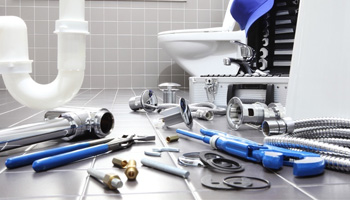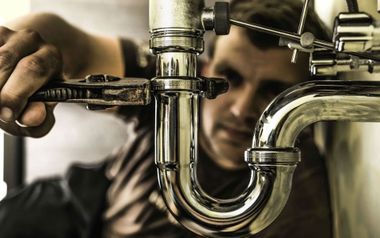A Guide to Your Property's Plumbing System Anatomy
A Guide to Your Property's Plumbing System Anatomy
Blog Article
We have uncovered this article relating to The Inner Workings of Your Home's Plumbing directly below on the net and decided it made perfect sense to quickly share it with you over here.

Comprehending exactly how your home's plumbing system functions is vital for each property owner. From delivering clean water for drinking, food preparation, and showering to safely removing wastewater, a well-maintained plumbing system is critical for your household's health and wellness and comfort. In this comprehensive guide, we'll discover the intricate network that comprises your home's plumbing and deal suggestions on upkeep, upgrades, and dealing with common problems.
Introduction
Your home's pipes system is greater than simply a network of pipes; it's an intricate system that guarantees you have accessibility to tidy water and reliable wastewater removal. Recognizing its elements and how they interact can aid you stop pricey repair work and make certain whatever runs efficiently.
Fundamental Components of a Plumbing System
Pipelines and Tubing
At the heart of your pipes system are the pipes and tubing that bring water throughout your home. These can be made from different products such as copper, PVC, or PEX, each with its benefits in terms of sturdiness and cost-effectiveness.
Components: Sinks, Toilets, Showers, etc.
Components like sinks, commodes, showers, and bathtubs are where water is made use of in your home. Comprehending just how these fixtures link to the pipes system assists in detecting troubles and intending upgrades.
Shutoffs and Shut-off Factors
Valves regulate the flow of water in your plumbing system. Shut-off valves are crucial throughout emergencies or when you need to make repairs, permitting you to separate parts of the system without interfering with water circulation to the entire house.
Water Supply System
Key Water Line
The major water line links your home to the community water system or a private well. It's where water enters your home and is dispersed to different fixtures.
Water Meter and Pressure Regulatory Authority
The water meter measures your water use, while a pressure regulator guarantees that water streams at a risk-free pressure throughout your home's plumbing system, stopping damages to pipelines and components.
Cold Water vs. Warm water Lines
Understanding the difference between cold water lines, which supply water straight from the major, and warm water lines, which lug heated water from the hot water heater, helps in troubleshooting and preparing for upgrades.
Water drainage System
Drain Water Lines and Traps
Drain pipes carry wastewater away from sinks, showers, and bathrooms to the drain or septic tank. Catches protect against drain gases from entering your home and also catch debris that can trigger obstructions.
Ventilation Pipelines
Ventilation pipelines allow air right into the water drainage system, avoiding suction that might slow down water drainage and cause catches to empty. Appropriate air flow is important for maintaining the stability of your pipes system.
Significance of Correct Drain
Guaranteeing correct drainage avoids backups and water damages. Routinely cleansing drains pipes and maintaining traps can prevent expensive fixings and extend the life of your pipes system.
Water Heating Unit
Sorts Of Water Heaters
Water heaters can be tankless or standard tank-style. Tankless heaters warm water as needed, while storage tanks store warmed water for prompt use.
How Water Heaters Link to the Pipes System
Recognizing how water heaters link to both the cold water supply and warm water distribution lines helps in identifying concerns like inadequate warm water or leaks.
Maintenance Tips for Water Heaters
Routinely flushing your water heater to eliminate debris, checking the temperature level setups, and inspecting for leaks can prolong its life expectancy and enhance power efficiency.
Typical Pipes Issues
Leaks and Their Causes
Leakages can take place due to aging pipelines, loosened installations, or high water pressure. Attending to leakages without delay stops water damages and mold growth.
Obstructions and Blockages
Obstructions in drains and toilets are typically brought on by flushing non-flushable products or an accumulation of oil and hair. Making use of drainpipe screens and being mindful of what drops your drains can prevent blockages.
Indicators of Pipes Problems to Watch For
Low water stress, slow-moving drains pipes, foul odors, or unusually high water expenses are indications of potential plumbing problems that ought to be addressed without delay.
Pipes Upkeep Tips
Normal Inspections and Checks
Schedule annual plumbing assessments to catch problems early. Try to find indicators of leakages, corrosion, or mineral accumulation in faucets and showerheads.
Do It Yourself Upkeep Tasks
Basic jobs like cleansing tap aerators, looking for commode leakages making use of color tablet computers, or shielding subjected pipes in cold environments can prevent major pipes concerns.
When to Call a Specialist Plumbing Professional
Know when a pipes concern needs expert know-how. Trying intricate repair services without appropriate expertise can cause more damages and greater fixing expenses.
Upgrading Your Plumbing System
Factors for Updating
Upgrading to water-efficient fixtures or replacing old pipelines can boost water top quality, lower water costs, and raise the worth of your home.
Modern Plumbing Technologies and Their Benefits
Explore technologies like clever leakage detectors, water-saving toilets, and energy-efficient water heaters that can save money and reduce ecological influence.
Cost Factors To Consider and ROI
Compute the upfront prices versus long-term financial savings when taking into consideration plumbing upgrades. Several upgrades spend for themselves with reduced energy expenses and fewer repairs.
Environmental Impact and Preservation
Water-Saving Components and Appliances
Setting up low-flow taps, showerheads, and toilets can dramatically decrease water use without compromising performance.
Tips for Lowering Water Usage
Straightforward practices like dealing with leaks immediately, taking shorter showers, and running complete tons of laundry and recipes can conserve water and lower your energy bills.
Eco-Friendly Pipes Options
Think about lasting plumbing materials like bamboo for floor covering, which is durable and green, or recycled glass for countertops.
Emergency situation Preparedness
Actions to Take During a Pipes Emergency
Know where your shut-off valves lie and just how to shut off the water supply in case of a burst pipeline or major leak.
Relevance of Having Emergency Situation Get In Touches With Helpful
Maintain contact information for regional plumbing professionals or emergency situation services conveniently offered for fast response throughout a plumbing crisis.
DIY Emergency Fixes (When Appropriate).
Momentary solutions like utilizing air duct tape to spot a dripping pipeline or placing a container under a leaking faucet can decrease damage up until an expert plumbing technician gets here.
Conclusion.
Comprehending the composition of your home's pipes system empowers you to maintain it effectively, saving money and time on fixings. By complying with regular maintenance routines and remaining educated concerning modern plumbing innovations, you can guarantee your pipes system runs successfully for years to come.
HOW YOUR PLUMBING SYSTEM WORKS
Which Pipes Do What?
Blue lines = fresh water supply entering the building
Red lines = hot water supply entering the building
Grey lines = pipes carrying waste away from the building and venting pipes carrying gases away from the building (through the roof)
YOUR MAIN PLUMBING SYSTEMS
There are two main plumbing systems that support your home s basic plumbing needs one that brings clean water into your home, and one that sends dirty water away from your home. Connected to the toilet, bath, shower, and other faucets in your home, these two systems keep your water flowing in the right directions.
ACCESSING FRESH WATER
Fresh and clean water is brought into your home through the main water supply line . Filtered through one pipe, this water is pressured to flow into the various fixtures in your home at any given time.
This water can be sourced from a well located on your property, a pond or river (mostly cottages), or, as in most cases, from the city s municipal water treatment centre. However, it is important to note that water that is untreated, such as the water siphoned from ponds or rivers, may not be safe to drink. Personal water supplies always need to be treated for hardness and contaminants before consumed.
MUNICIPAL WATER SUPPLIES
Improve taste and odour
Remove sediment
Eliminate hardness
Reduce chlorine
COLD WATER SUPPLY VS. HOT WATER SUPPLY
Cold water flows into your home or building through the service line, which then distributes hot or cold water to your fixtures. This line is most commonly run through a central column that runs floor to floor. Hot water runs in short and straight pipes as the longer the pipeline, the more heat that will be lost in the transfer. Having shorter pipes also allows residents to access hot water more quickly.
WASTE WATER SYSTEM
Your wastewater system is divided into two parts pipes that send wastewater away from your home and venting pipes that send sewer gas away from your home. Sewage water travels through pipes that flush the water and waste towards local sewers that are operated and managed by your city or town. Most sewer systems rely on gravity to move the wastewater to where it needs to go.
The further away from your toilet or sink, the larger wastewater pipes become. This allows for waste to be disposed of from various parts of your home or business at once without pipe blockages. The angle and flow of these pipes are also essential for keeping your waste pipes clear of build up.
https://harrisplumbing.ca/how-your-home-plumbing-system-works/

HOW YOUR PLUMBING SYSTEM WORKS
Which Pipes Do What?
YOUR MAIN PLUMBING SYSTEMS
There are two main plumbing systems that support your home s basic plumbing needs one that brings clean water into your home, and one that sends dirty water away from your home. Connected to the toilet, bath, shower, and other faucets in your home, these two systems keep your water flowing in the right directions.
ACCESSING FRESH WATER
Fresh and clean water is brought into your home through the main water supply line . Filtered through one pipe, this water is pressured to flow into the various fixtures in your home at any given time.
This water can be sourced from a well located on your property, a pond or river (mostly cottages), or, as in most cases, from the city s municipal water treatment centre. However, it is important to note that water that is untreated, such as the water siphoned from ponds or rivers, may not be safe to drink. Personal water supplies always need to be treated for hardness and contaminants before consumed.
MUNICIPAL WATER SUPPLIES
COLD WATER SUPPLY VS. HOT WATER SUPPLY
Cold water flows into your home or building through the service line, which then distributes hot or cold water to your fixtures. This line is most commonly run through a central column that runs floor to floor. Hot water runs in short and straight pipes as the longer the pipeline, the more heat that will be lost in the transfer. Having shorter pipes also allows residents to access hot water more quickly.
WASTE WATER SYSTEM
Your wastewater system is divided into two parts pipes that send wastewater away from your home and venting pipes that send sewer gas away from your home. Sewage water travels through pipes that flush the water and waste towards local sewers that are operated and managed by your city or town. Most sewer systems rely on gravity to move the wastewater to where it needs to go.
The further away from your toilet or sink, the larger wastewater pipes become. This allows for waste to be disposed of from various parts of your home or business at once without pipe blockages. The angle and flow of these pipes are also essential for keeping your waste pipes clear of build up.
https://harrisplumbing.ca/how-your-home-plumbing-system-works/
I recently found that piece on Understanding Your Home's Plumbing Anatomy when exploring the internet. Do you know about anybody else who is in to Exploring Your Homes Plumbing Anatomy? Feel free to promote it. Thank you for your time. Don't hesitate to come visit our website back soon.
Book Your Appointment Report this page